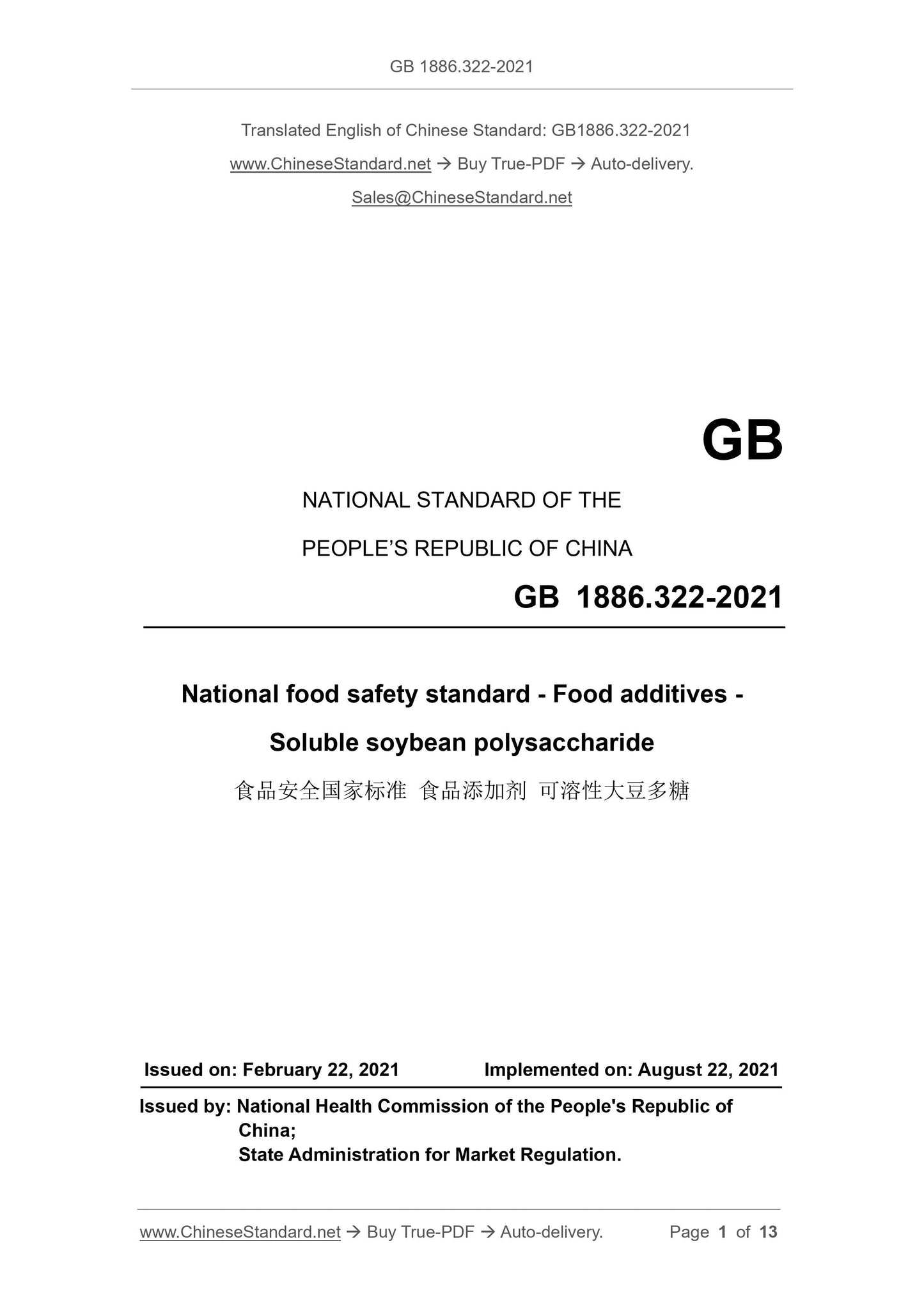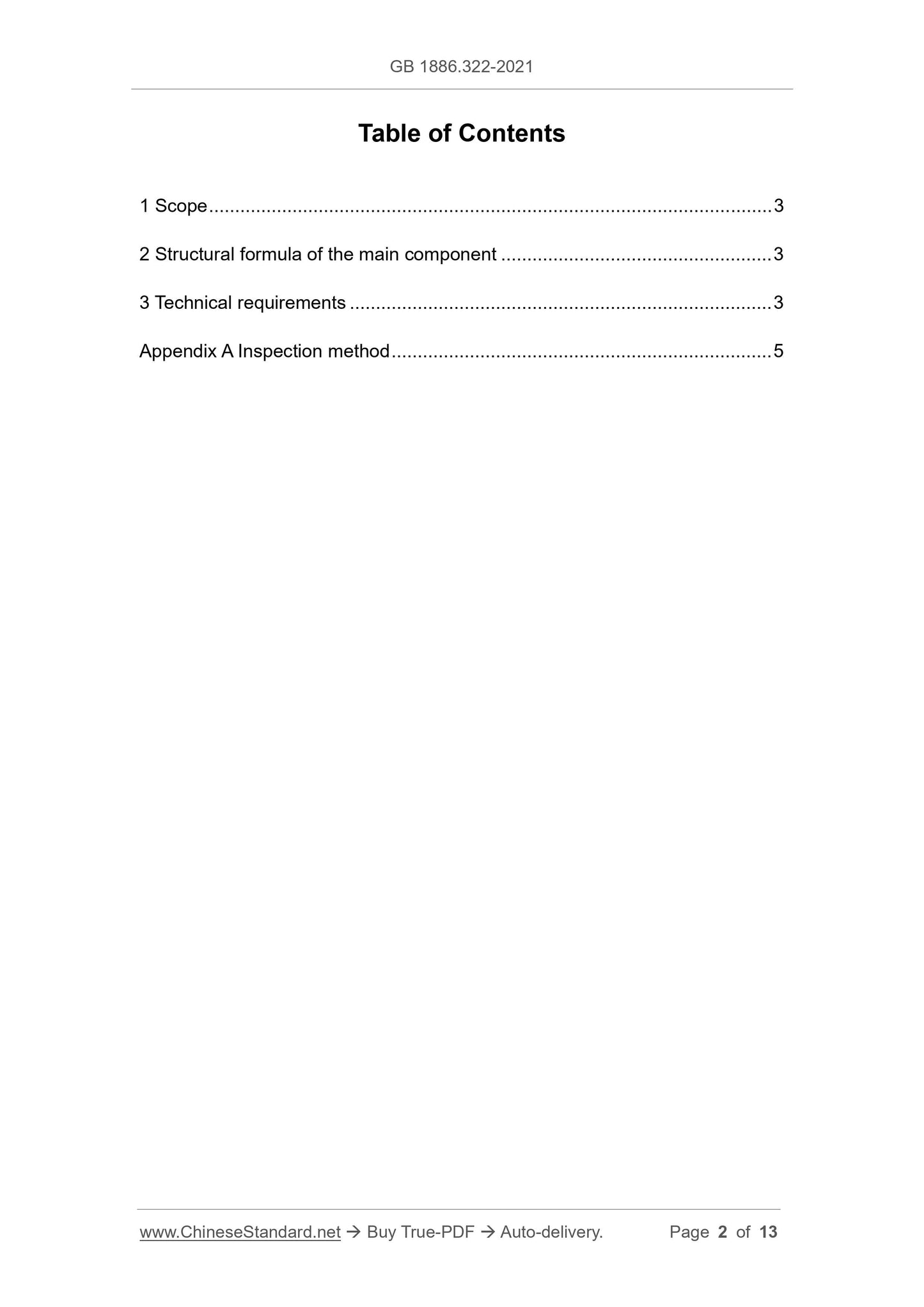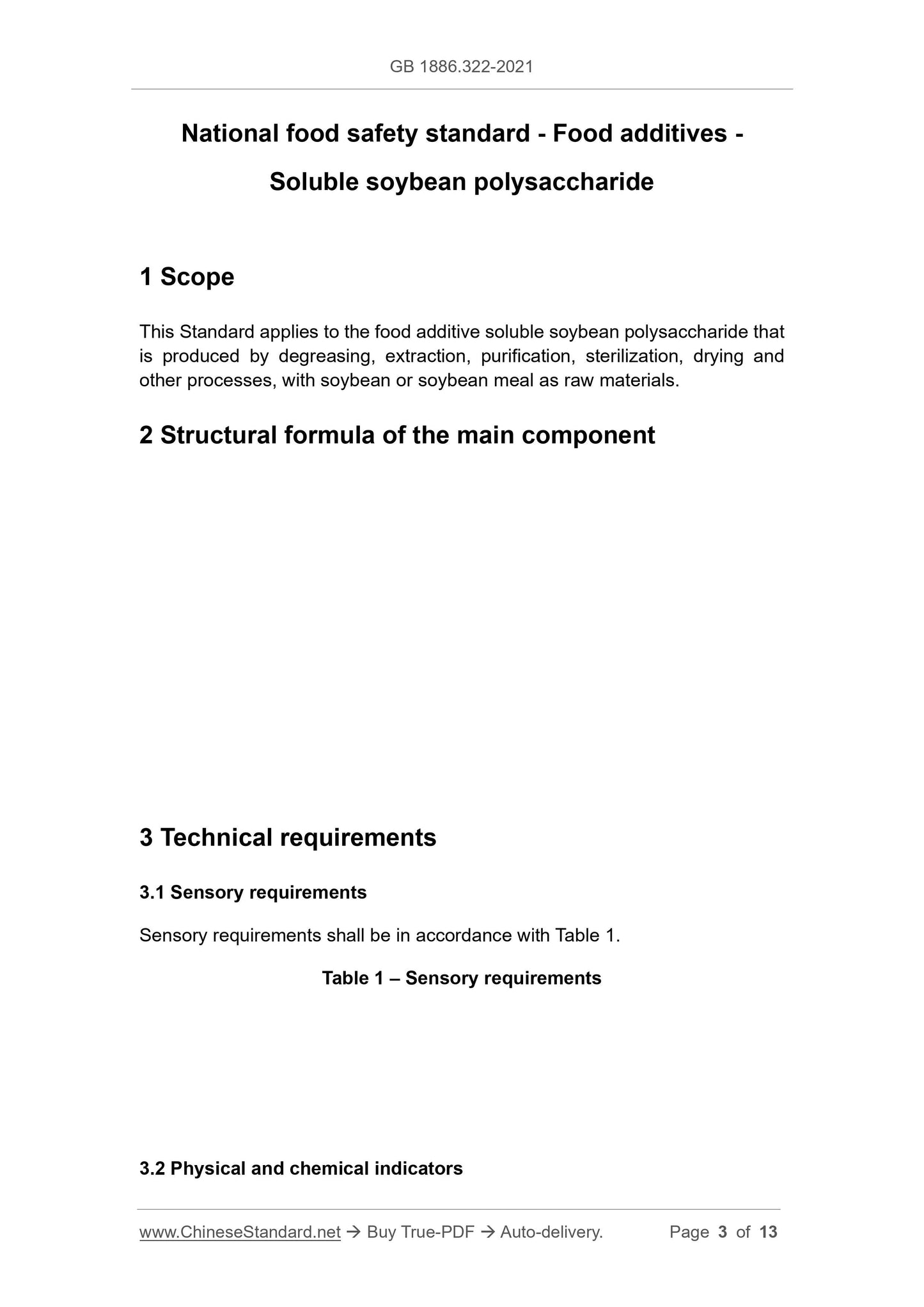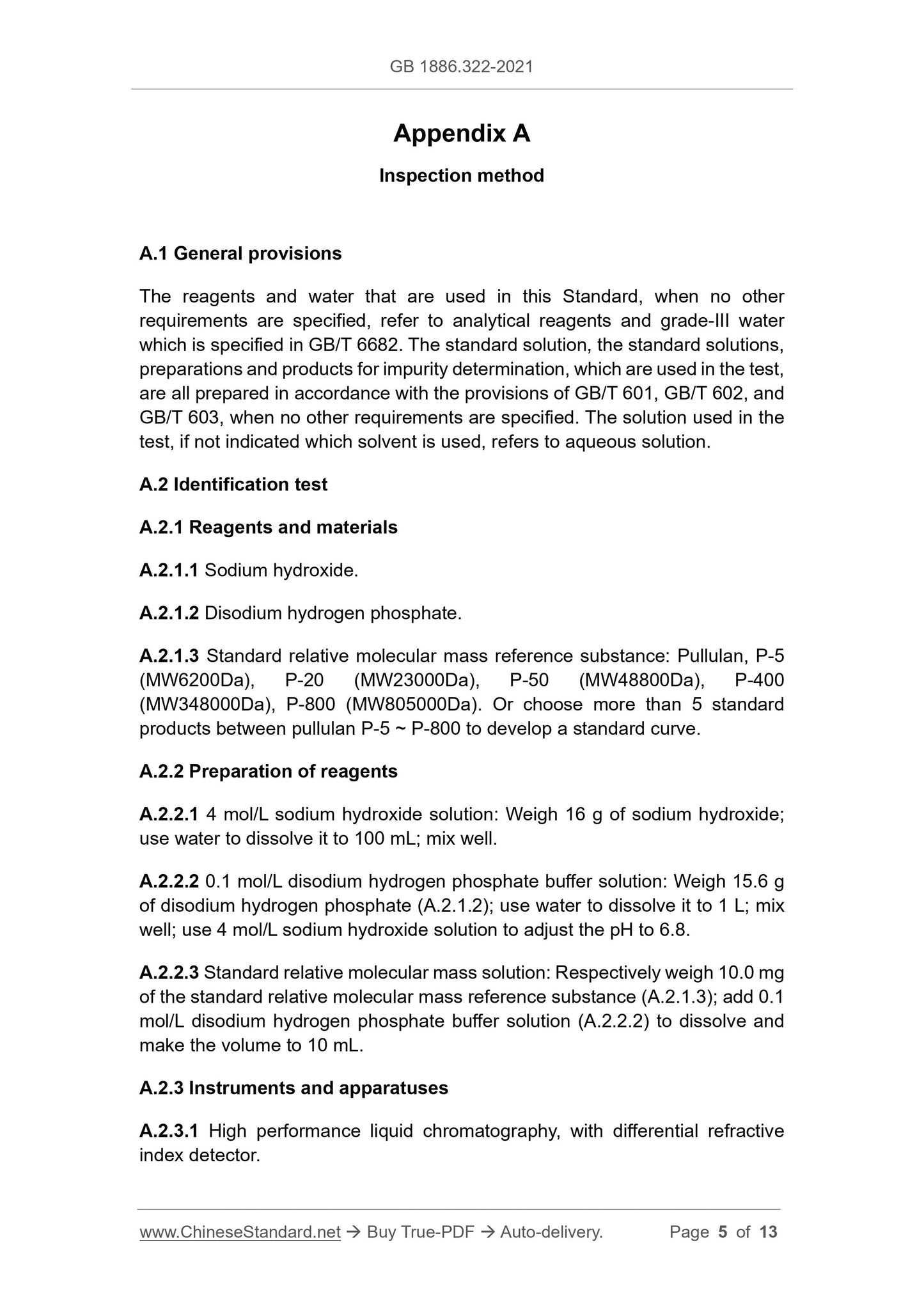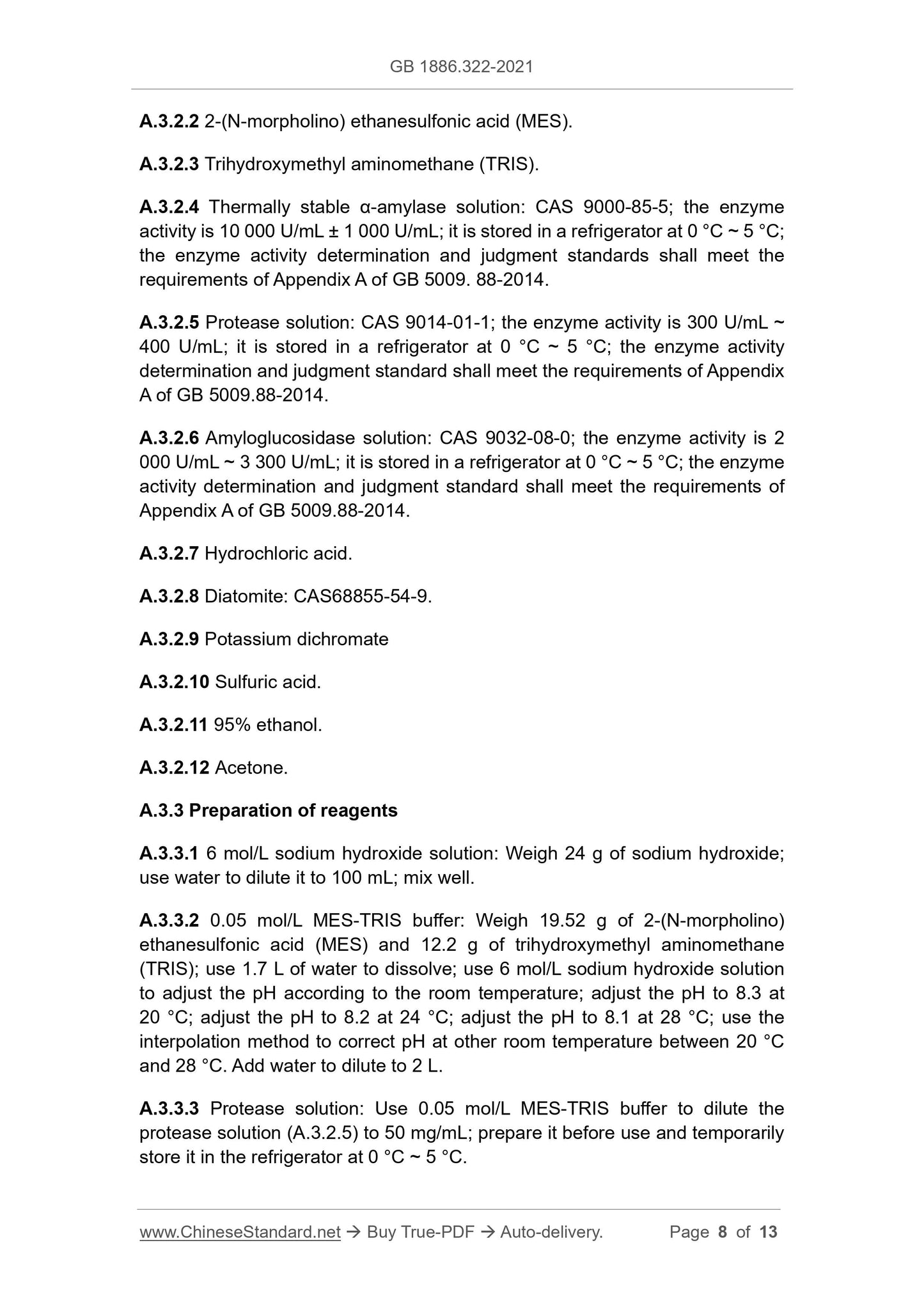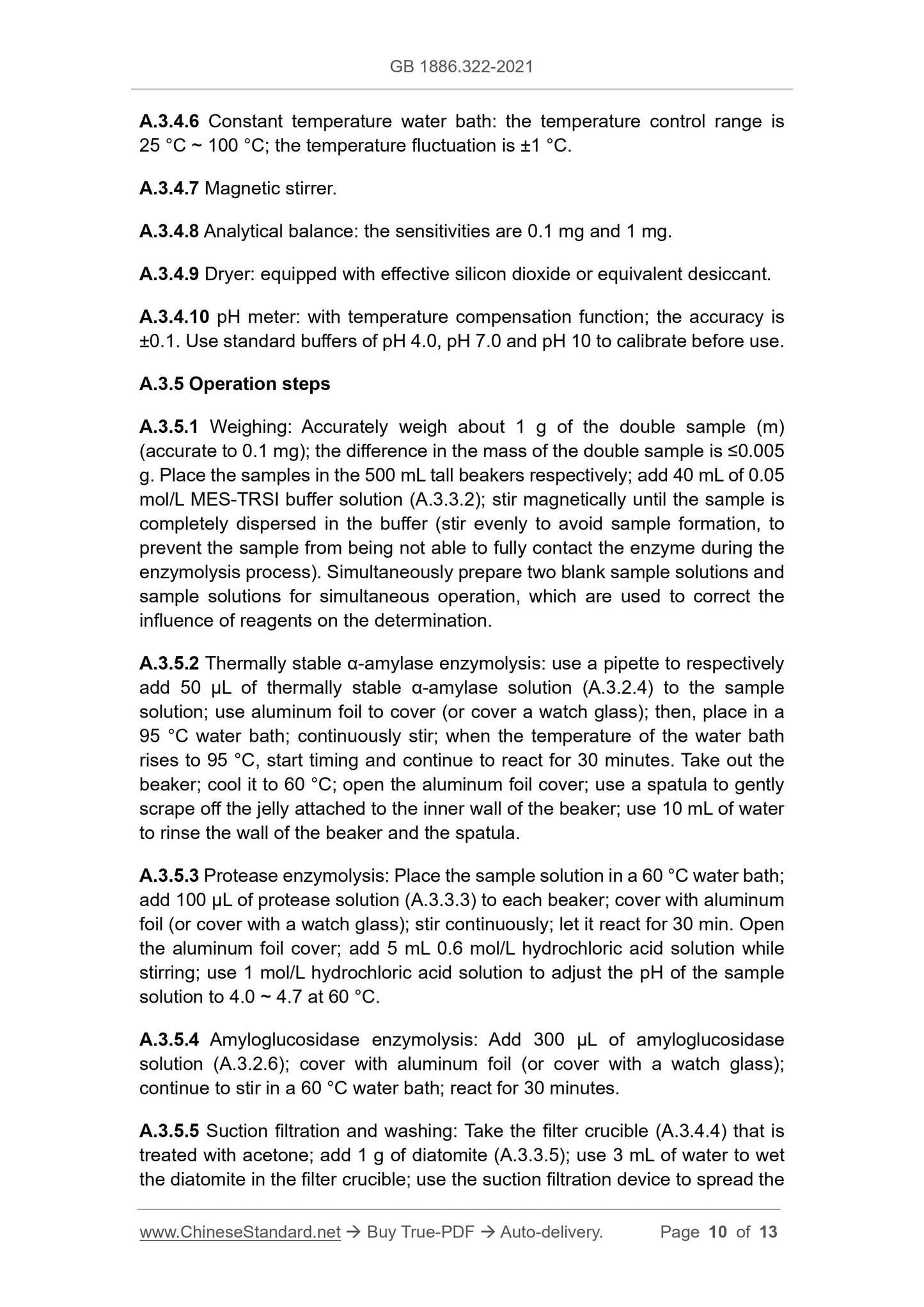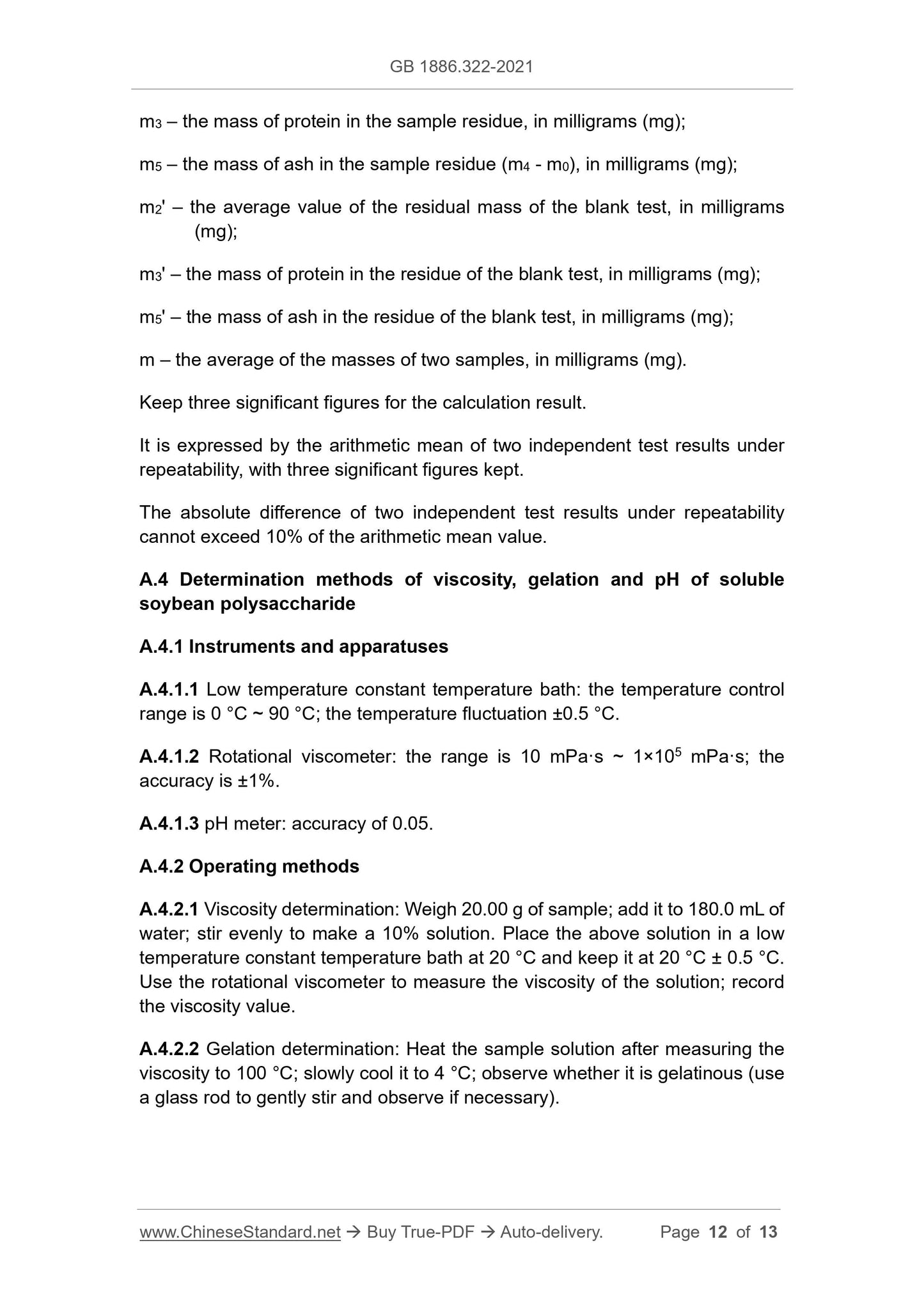1
/
of
7
www.ChineseStandard.us -- Field Test Asia Pte. Ltd.
GB 1886.322-2021 English PDF
GB 1886.322-2021 English PDF
Regular price
$125.00
Regular price
Sale price
$125.00
Unit price
/
per
Shipping calculated at checkout.
Couldn't load pickup availability
GB 1886.322-2021: National food safety standard - Food additives - Soluble soybean polysaccharide
Delivery: 9 seconds. Download (& Email) true-PDF + Invoice.
Get Quotation: Click GB 1886.322-2021 (Self-service in 1-minute)
Historical versions (Master-website): GB 1886.322-2021
Preview True-PDF (Reload/Scroll-down if blank)
GB 1886.322-2021
GB
NATIONAL STANDARD OF THE
PEOPLE’S REPUBLIC OF CHINA
National food safety standard - Food additives -
Soluble soybean polysaccharide
ISSUED ON: FEBRUARY 22, 2021
IMPLEMENTED ON: AUGUST 22, 2021
Issued by: National Health Commission of the People's Republic of
China;
State Administration for Market Regulation.
Table of Contents
1 Scope ... 3
2 Structural formula of the main component ... 3
3 Technical requirements ... 3
Appendix A Inspection method ... 5
National food safety standard - Food additives -
Soluble soybean polysaccharide
1 Scope
This Standard applies to the food additive soluble soybean polysaccharide that
is produced by degreasing, extraction, purification, sterilization, drying and
other processes, with soybean or soybean meal as raw materials.
2 Structural formula of the main component
3 Technical requirements
3.1 Sensory requirements
Sensory requirements shall be in accordance with Table 1.
Table 1 – Sensory requirements
3.2 Physical and chemical indicators
Appendix A
Inspection method
A.1 General provisions
The reagents and water that are used in this Standard, when no other
requirements are specified, refer to analytical reagents and grade-III water
which is specified in GB/T 6682. The standard solution, the standard solutions,
preparations and products for impurity determination, which are used in the test,
are all prepared in accordance with the provisions of GB/T 601, GB/T 602, and
GB/T 603, when no other requirements are specified. The solution used in the
test, if not indicated which solvent is used, refers to aqueous solution.
A.2 Identification test
A.2.1 Reagents and materials
A.2.1.1 Sodium hydroxide.
A.2.1.2 Disodium hydrogen phosphate.
A.2.1.3 Standard relative molecular mass reference substance: Pullulan, P-5
(MW6200Da), P-20 (MW23000Da), P-50 (MW48800Da), P-400
(MW348000Da), P-800 (MW805000Da). Or choose more than 5 standard
products between pullulan P-5 ~ P-800 to develop a standard curve.
A.2.2 Preparation of reagents
A.2.2.1 4 mol/L sodium hydroxide solution: Weigh 16 g of sodium hydroxide;
use water to dissolve it to 100 mL; mix well.
A.2.2.2 0.1 mol/L disodium hydrogen phosphate buffer solution: Weigh 15.6 g
of disodium hydrogen phosphate (A.2.1.2); use water to dissolve it to 1 L; mix
well; use 4 mol/L sodium hydroxide solution to adjust the pH to 6.8.
A.2.2.3 Standard relative molecular mass solution: Respectively weigh 10.0 mg
of the standard relative molecular mass reference substance (A.2.1.3); add 0.1
mol/L disodium hydrogen phosphate buffer solution (A.2.2.2) to dissolve and
make the volume to 10 mL.
A.2.3 Instruments and apparatuses
A.2.3.1 High performance liquid chromatography, with differential refractive
index detector.
A.3.2.2 2-(N-morpholino) ethanesulfonic acid (MES).
A.3.2.3 Trihydroxymethyl aminomethane (TRIS).
A.3.2.4 Thermally stable α-amylase solution: CAS 9000-85-5; the enzyme
activity is 10 000 U/mL ± 1 000 U/mL; it is stored in a refrigerator at 0 °C ~ 5 °C;
the enzyme activity determination and judgment standards shall meet the
requirements of Appendix A of GB 5009. 88-2014.
A.3.2.5 Protease solution: CAS 9014-01-1; the enzyme activity is 300 U/mL ~
400 U/mL; it is stored in a refrigerator at 0 °C ~ 5 °C; the enzyme activity
determination and judgment standard shall meet the requirements of Appendix
A of GB 5009.88-2014.
A.3.2.6 Amyloglucosidase solution: CAS 9032-08-0; the enzyme activity is 2
000 U/mL ~ 3 300 U/mL; it is stored in a refrigerator at 0 °C ~ 5 °C; the enzyme
activity determination and judgment standard shall meet the requirements of
Appendix A of GB 5009.88-2014.
A.3.2.7 Hydrochloric acid.
A.3.2.8 Diatomite: CAS68855-54-9.
A.3.2.9 Potassium dichromate
A.3.2.10 Sulfuric acid.
A.3.2.11 95% ethanol.
A.3.2.12 Acetone.
A.3.3 Preparation of reagents
A.3.3.1 6 mol/L sodium hydroxide solution: Weigh 24 g of sodium hydroxide;
use water to dilute it to 100 mL; mix well.
A.3.3.2 0.05 mol/L MES-TRIS buffer: Weigh 19.52 g of 2-(N-morpholino)
ethanesulfonic acid (MES) and 12.2 g of trihydroxymethyl aminomethane
(TRIS); use 1.7 L of water to dissolve; use 6 mol/L sodium hydroxide solution
to adjust the pH according to the room temperature; adjust the pH to 8.3 at
20 °C; adjust the pH to 8.2 at 24 °C; adjust the pH to 8.1 at 28 °C; use the
interpolation method to correct pH at other room temperature between 20 °C
and 28 °C. Add water to dilute to 2 L.
A.3.3.3 Protease solution: Use 0.05 mol/L MES-TRIS buffer to dilute the
protease solution (A.3.2.5) to 50 mg/mL; prepare it before use and temporarily
store it in the refrigerator at 0 °C ~ 5 °C.
A.3.4.6 Constant temperature water bath: the temperature control range is
25 °C ~ 100 °C; the temperature fluctuation is ±1 °C.
A.3.4.7 Magnetic stirrer.
A.3.4.8 Analytical balance: the sensitivities are 0.1 mg and 1 mg.
A.3.4.9 Dryer: equipped with effective silicon dioxide or equivalent desiccant.
A.3.4.10 pH meter: with temperature compensation function; the accuracy is
±0.1. Use standard buffers of pH 4.0, pH 7.0 and pH 10 to calibrate before use.
A.3.5 Operation steps
A.3.5.1 Weighing: Accurately weigh about 1 g of the double sample (m)
(accurate to 0.1 mg); the difference in the mass of the double sample is ≤0.005
g. Place the samples in the 500 mL tall beakers respectively; add 40 mL of 0.05
mol/L MES-TRSI buffer solution (A.3.3.2); stir magnetically until the sample is
completely dispersed in the buffer (stir evenly to avoid sample formation, to
prevent the sample from being not able to fully contact the enzyme during the
enzymolysis process). Simultaneously prepare two blank sample solutions and
sample solutions for simultaneous operation, which are used to correct the
influence of reagents on the determination.
A.3.5.2 Thermally stable α-amylase enzymolysis: use a pipette to respectively
add 50 μL of thermally stable α-amylase solution (A.3.2.4) to the sample
solution; use aluminum foil to cover (or cover a watch glass); then, place in a
95 °C water bath; continuously stir; when the temperature of the water bath
rises to 95 °C, start timing and continue to react for 30 minutes. Take out the
beaker; cool it to 60 °C; open the aluminum foil cover; use a spatula to gently
scrape off the jelly attached to the inner wall of the beaker; use 10 mL of water
to rinse the wall of the beaker and the spatula.
A.3.5.3 Protease enzymolysis: Place the sample solution in a 60 °C water bath;
add 100 μL of protease solution (A.3.3.3) to each beaker; cover with aluminum
foil (or cover with a watch glass); stir continuously; let it react for 30 min. Open
the aluminum foil cover; add 5 mL 0.6 mol/L hydrochloric acid solution while
stirring; use 1 mol/L hydrochloric acid solution to adjust the pH of the sample
solution to 4.0 ~ 4.7 at 60 °C.
A.3.5.4 Amyloglucosidase enzymolysis: Add 300 μL of amyloglucosidase
solution (A.3.2.6); cover with aluminum foil (or cover with a watch glass);
continue to stir in a 60 °C water bath; react for 30 minutes.
A.3.5.5 Suction filtration and washing: Take the filter crucible (A.3.4.4) that is
treated with acetone; add 1 g of diatomite (A.3.3.5); use 3 mL of water to wet
the diatomite in the filter crucible; use the suction filtration device to spread the
m3 – the mass of protein in the sample residue, in milligrams (mg);
m5 – the mass of ash in the sample residue (m4 - m0), in milligrams (mg);
m2' – the average value of the residual mass of the blank test, in milligrams
(mg);
m3' – the mass of protein in the residue of the blank test, in milligrams (mg);
m5' – the mass of ash in the residue of the blank test, in milligrams (mg);
m – the average of the masses of two samples, in milligrams (mg).
Keep three significant figures for the calculation result.
It is expressed by the arithmetic mean of two independent test results under
repeatability, with three significant figures kept.
The absolute difference of two independent test results under repeatability
cannot exceed 10% of the arithmetic mean value.
A.4 Determination methods of viscosity, gelation and pH of soluble
soybean polysaccharide
A.4.1 Instruments and apparatuses
A.4.1.1 Low temperature constant temperature bath: the temperature control
range is 0 °C ~ 90 °C; the temperature fluctuation ±0.5 °C.
A.4.1.2 Rotational viscometer: the range is 10 mPa·s ~ 1×105 mPa·s; the
accuracy is ±1%.
A.4.1.3 pH meter: accuracy of 0.05.
A.4.2 Operating methods
A.4.2.1 Viscosity determination: Weigh 20.00 g of sample; add it to 180.0 mL of
water; stir evenly to make a 10% solution. Place the above solution in a low
temperature constant temperature bath at 20 °C and keep it at 20 °C ± 0.5 °C.
Use the rotational viscometer to measure the viscosity of the solution; record
the viscosity value.
A.4.2.2 Gelation determination: Heat the sample solution after measuring the
viscosity to 100 °C; slowly cool it to 4 °C; observe whether it is gelatinous (use
a glass rod to gently stir and observe if necessary).
GB 1886.322-2021
GB
NATIONAL STANDARD OF THE
PEOPLE’S REPUBLIC OF CHINA
National food safety standard - Food additives -
Soluble soybean polysaccharide
ISSUED ON: FEBRUARY 22, 2021
IMPLEMENTED ON: AUGUST 22, 2021
Issued by: National Health Commission of the People's Republic of
China;
State Administration for Market Regulation.
Table of Contents
1 Scope ... 3
2 Structural formula of the main component ... 3
3 Technical requirements ... 3
Appendix A Inspection method ... 5
National food safety standard - Food additives -
Soluble soybean polysaccharide
1 Scope
This Standard applies to the food additive soluble soybean polysaccharide that
is produced by degreasing, extraction, purification, sterilization, drying and
other processes, with soybean or soybean meal as raw materials.
2 Structural formula of the main component
3 Technical requirements
3.1 Sensory requirements
Sensory requirements shall be in accordance with Table 1.
Table 1 – Sensory requirements
3.2 Physical and chemical indicators
Appendix A
Inspection method
A.1 General provisions
The reagents and water that are used in this Standard, when no other
requirements are specified, refer to analytical reagents and grade-III water
which is specified in GB/T 6682. The standard solution, the standard solutions,
preparations and products for impurity determination, which are used in the test,
are all prepared in accordance with the provisions of GB/T 601, GB/T 602, and
GB/T 603, when no other requirements are specified. The solution used in the
test, if not indicated which solvent is used, refers to aqueous solution.
A.2 Identification test
A.2.1 Reagents and materials
A.2.1.1 Sodium hydroxide.
A.2.1.2 Disodium hydrogen phosphate.
A.2.1.3 Standard relative molecular mass reference substance: Pullulan, P-5
(MW6200Da), P-20 (MW23000Da), P-50 (MW48800Da), P-400
(MW348000Da), P-800 (MW805000Da). Or choose more than 5 standard
products between pullulan P-5 ~ P-800 to develop a standard curve.
A.2.2 Preparation of reagents
A.2.2.1 4 mol/L sodium hydroxide solution: Weigh 16 g of sodium hydroxide;
use water to dissolve it to 100 mL; mix well.
A.2.2.2 0.1 mol/L disodium hydrogen phosphate buffer solution: Weigh 15.6 g
of disodium hydrogen phosphate (A.2.1.2); use water to dissolve it to 1 L; mix
well; use 4 mol/L sodium hydroxide solution to adjust the pH to 6.8.
A.2.2.3 Standard relative molecular mass solution: Respectively weigh 10.0 mg
of the standard relative molecular mass reference substance (A.2.1.3); add 0.1
mol/L disodium hydrogen phosphate buffer solution (A.2.2.2) to dissolve and
make the volume to 10 mL.
A.2.3 Instruments and apparatuses
A.2.3.1 High performance liquid chromatography, with differential refractive
index detector.
A.3.2.2 2-(N-morpholino) ethanesulfonic acid (MES).
A.3.2.3 Trihydroxymethyl aminomethane (TRIS).
A.3.2.4 Thermally stable α-amylase solution: CAS 9000-85-5; the enzyme
activity is 10 000 U/mL ± 1 000 U/mL; it is stored in a refrigerator at 0 °C ~ 5 °C;
the enzyme activity determination and judgment standards shall meet the
requirements of Appendix A of GB 5009. 88-2014.
A.3.2.5 Protease solution: CAS 9014-01-1; the enzyme activity is 300 U/mL ~
400 U/mL; it is stored in a refrigerator at 0 °C ~ 5 °C; the enzyme activity
determination and judgment standard shall meet the requirements of Appendix
A of GB 5009.88-2014.
A.3.2.6 Amyloglucosidase solution: CAS 9032-08-0; the enzyme activity is 2
000 U/mL ~ 3 300 U/mL; it is stored in a refrigerator at 0 °C ~ 5 °C; the enzyme
activity determination and judgment standard shall meet the requirements of
Appendix A of GB 5009.88-2014.
A.3.2.7 Hydrochloric acid.
A.3.2.8 Diatomite: CAS68855-54-9.
A.3.2.9 Potassium dichromate
A.3.2.10 Sulfuric acid.
A.3.2.11 95% ethanol.
A.3.2.12 Acetone.
A.3.3 Preparation of reagents
A.3.3.1 6 mol/L sodium hydroxide solution: Weigh 24 g of sodium hydroxide;
use water to dilute it to 100 mL; mix well.
A.3.3.2 0.05 mol/L MES-TRIS buffer: Weigh 19.52 g of 2-(N-morpholino)
ethanesulfonic acid (MES) and 12.2 g of trihydroxymethyl aminomethane
(TRIS); use 1.7 L of water to dissolve; use 6 mol/L sodium hydroxide solution
to adjust the pH according to the room temperature; adjust the pH to 8.3 at
20 °C; adjust the pH to 8.2 at 24 °C; adjust the pH to 8.1 at 28 °C; use the
interpolation method to correct pH at other room temperature between 20 °C
and 28 °C. Add water to dilute to 2 L.
A.3.3.3 Protease solution: Use 0.05 mol/L MES-TRIS buffer to dilute the
protease solution (A.3.2.5) to 50 mg/mL; prepare it before use and temporarily
store it in the refrigerator at 0 °C ~ 5 °C.
A.3.4.6 Constant temperature water bath: the temperature control range is
25 °C ~ 100 °C; the temperature fluctuation is ±1 °C.
A.3.4.7 Magnetic stirrer.
A.3.4.8 Analytical ...
Delivery: 9 seconds. Download (& Email) true-PDF + Invoice.
Get Quotation: Click GB 1886.322-2021 (Self-service in 1-minute)
Historical versions (Master-website): GB 1886.322-2021
Preview True-PDF (Reload/Scroll-down if blank)
GB 1886.322-2021
GB
NATIONAL STANDARD OF THE
PEOPLE’S REPUBLIC OF CHINA
National food safety standard - Food additives -
Soluble soybean polysaccharide
ISSUED ON: FEBRUARY 22, 2021
IMPLEMENTED ON: AUGUST 22, 2021
Issued by: National Health Commission of the People's Republic of
China;
State Administration for Market Regulation.
Table of Contents
1 Scope ... 3
2 Structural formula of the main component ... 3
3 Technical requirements ... 3
Appendix A Inspection method ... 5
National food safety standard - Food additives -
Soluble soybean polysaccharide
1 Scope
This Standard applies to the food additive soluble soybean polysaccharide that
is produced by degreasing, extraction, purification, sterilization, drying and
other processes, with soybean or soybean meal as raw materials.
2 Structural formula of the main component
3 Technical requirements
3.1 Sensory requirements
Sensory requirements shall be in accordance with Table 1.
Table 1 – Sensory requirements
3.2 Physical and chemical indicators
Appendix A
Inspection method
A.1 General provisions
The reagents and water that are used in this Standard, when no other
requirements are specified, refer to analytical reagents and grade-III water
which is specified in GB/T 6682. The standard solution, the standard solutions,
preparations and products for impurity determination, which are used in the test,
are all prepared in accordance with the provisions of GB/T 601, GB/T 602, and
GB/T 603, when no other requirements are specified. The solution used in the
test, if not indicated which solvent is used, refers to aqueous solution.
A.2 Identification test
A.2.1 Reagents and materials
A.2.1.1 Sodium hydroxide.
A.2.1.2 Disodium hydrogen phosphate.
A.2.1.3 Standard relative molecular mass reference substance: Pullulan, P-5
(MW6200Da), P-20 (MW23000Da), P-50 (MW48800Da), P-400
(MW348000Da), P-800 (MW805000Da). Or choose more than 5 standard
products between pullulan P-5 ~ P-800 to develop a standard curve.
A.2.2 Preparation of reagents
A.2.2.1 4 mol/L sodium hydroxide solution: Weigh 16 g of sodium hydroxide;
use water to dissolve it to 100 mL; mix well.
A.2.2.2 0.1 mol/L disodium hydrogen phosphate buffer solution: Weigh 15.6 g
of disodium hydrogen phosphate (A.2.1.2); use water to dissolve it to 1 L; mix
well; use 4 mol/L sodium hydroxide solution to adjust the pH to 6.8.
A.2.2.3 Standard relative molecular mass solution: Respectively weigh 10.0 mg
of the standard relative molecular mass reference substance (A.2.1.3); add 0.1
mol/L disodium hydrogen phosphate buffer solution (A.2.2.2) to dissolve and
make the volume to 10 mL.
A.2.3 Instruments and apparatuses
A.2.3.1 High performance liquid chromatography, with differential refractive
index detector.
A.3.2.2 2-(N-morpholino) ethanesulfonic acid (MES).
A.3.2.3 Trihydroxymethyl aminomethane (TRIS).
A.3.2.4 Thermally stable α-amylase solution: CAS 9000-85-5; the enzyme
activity is 10 000 U/mL ± 1 000 U/mL; it is stored in a refrigerator at 0 °C ~ 5 °C;
the enzyme activity determination and judgment standards shall meet the
requirements of Appendix A of GB 5009. 88-2014.
A.3.2.5 Protease solution: CAS 9014-01-1; the enzyme activity is 300 U/mL ~
400 U/mL; it is stored in a refrigerator at 0 °C ~ 5 °C; the enzyme activity
determination and judgment standard shall meet the requirements of Appendix
A of GB 5009.88-2014.
A.3.2.6 Amyloglucosidase solution: CAS 9032-08-0; the enzyme activity is 2
000 U/mL ~ 3 300 U/mL; it is stored in a refrigerator at 0 °C ~ 5 °C; the enzyme
activity determination and judgment standard shall meet the requirements of
Appendix A of GB 5009.88-2014.
A.3.2.7 Hydrochloric acid.
A.3.2.8 Diatomite: CAS68855-54-9.
A.3.2.9 Potassium dichromate
A.3.2.10 Sulfuric acid.
A.3.2.11 95% ethanol.
A.3.2.12 Acetone.
A.3.3 Preparation of reagents
A.3.3.1 6 mol/L sodium hydroxide solution: Weigh 24 g of sodium hydroxide;
use water to dilute it to 100 mL; mix well.
A.3.3.2 0.05 mol/L MES-TRIS buffer: Weigh 19.52 g of 2-(N-morpholino)
ethanesulfonic acid (MES) and 12.2 g of trihydroxymethyl aminomethane
(TRIS); use 1.7 L of water to dissolve; use 6 mol/L sodium hydroxide solution
to adjust the pH according to the room temperature; adjust the pH to 8.3 at
20 °C; adjust the pH to 8.2 at 24 °C; adjust the pH to 8.1 at 28 °C; use the
interpolation method to correct pH at other room temperature between 20 °C
and 28 °C. Add water to dilute to 2 L.
A.3.3.3 Protease solution: Use 0.05 mol/L MES-TRIS buffer to dilute the
protease solution (A.3.2.5) to 50 mg/mL; prepare it before use and temporarily
store it in the refrigerator at 0 °C ~ 5 °C.
A.3.4.6 Constant temperature water bath: the temperature control range is
25 °C ~ 100 °C; the temperature fluctuation is ±1 °C.
A.3.4.7 Magnetic stirrer.
A.3.4.8 Analytical balance: the sensitivities are 0.1 mg and 1 mg.
A.3.4.9 Dryer: equipped with effective silicon dioxide or equivalent desiccant.
A.3.4.10 pH meter: with temperature compensation function; the accuracy is
±0.1. Use standard buffers of pH 4.0, pH 7.0 and pH 10 to calibrate before use.
A.3.5 Operation steps
A.3.5.1 Weighing: Accurately weigh about 1 g of the double sample (m)
(accurate to 0.1 mg); the difference in the mass of the double sample is ≤0.005
g. Place the samples in the 500 mL tall beakers respectively; add 40 mL of 0.05
mol/L MES-TRSI buffer solution (A.3.3.2); stir magnetically until the sample is
completely dispersed in the buffer (stir evenly to avoid sample formation, to
prevent the sample from being not able to fully contact the enzyme during the
enzymolysis process). Simultaneously prepare two blank sample solutions and
sample solutions for simultaneous operation, which are used to correct the
influence of reagents on the determination.
A.3.5.2 Thermally stable α-amylase enzymolysis: use a pipette to respectively
add 50 μL of thermally stable α-amylase solution (A.3.2.4) to the sample
solution; use aluminum foil to cover (or cover a watch glass); then, place in a
95 °C water bath; continuously stir; when the temperature of the water bath
rises to 95 °C, start timing and continue to react for 30 minutes. Take out the
beaker; cool it to 60 °C; open the aluminum foil cover; use a spatula to gently
scrape off the jelly attached to the inner wall of the beaker; use 10 mL of water
to rinse the wall of the beaker and the spatula.
A.3.5.3 Protease enzymolysis: Place the sample solution in a 60 °C water bath;
add 100 μL of protease solution (A.3.3.3) to each beaker; cover with aluminum
foil (or cover with a watch glass); stir continuously; let it react for 30 min. Open
the aluminum foil cover; add 5 mL 0.6 mol/L hydrochloric acid solution while
stirring; use 1 mol/L hydrochloric acid solution to adjust the pH of the sample
solution to 4.0 ~ 4.7 at 60 °C.
A.3.5.4 Amyloglucosidase enzymolysis: Add 300 μL of amyloglucosidase
solution (A.3.2.6); cover with aluminum foil (or cover with a watch glass);
continue to stir in a 60 °C water bath; react for 30 minutes.
A.3.5.5 Suction filtration and washing: Take the filter crucible (A.3.4.4) that is
treated with acetone; add 1 g of diatomite (A.3.3.5); use 3 mL of water to wet
the diatomite in the filter crucible; use the suction filtration device to spread the
m3 – the mass of protein in the sample residue, in milligrams (mg);
m5 – the mass of ash in the sample residue (m4 - m0), in milligrams (mg);
m2' – the average value of the residual mass of the blank test, in milligrams
(mg);
m3' – the mass of protein in the residue of the blank test, in milligrams (mg);
m5' – the mass of ash in the residue of the blank test, in milligrams (mg);
m – the average of the masses of two samples, in milligrams (mg).
Keep three significant figures for the calculation result.
It is expressed by the arithmetic mean of two independent test results under
repeatability, with three significant figures kept.
The absolute difference of two independent test results under repeatability
cannot exceed 10% of the arithmetic mean value.
A.4 Determination methods of viscosity, gelation and pH of soluble
soybean polysaccharide
A.4.1 Instruments and apparatuses
A.4.1.1 Low temperature constant temperature bath: the temperature control
range is 0 °C ~ 90 °C; the temperature fluctuation ±0.5 °C.
A.4.1.2 Rotational viscometer: the range is 10 mPa·s ~ 1×105 mPa·s; the
accuracy is ±1%.
A.4.1.3 pH meter: accuracy of 0.05.
A.4.2 Operating methods
A.4.2.1 Viscosity determination: Weigh 20.00 g of sample; add it to 180.0 mL of
water; stir evenly to make a 10% solution. Place the above solution in a low
temperature constant temperature bath at 20 °C and keep it at 20 °C ± 0.5 °C.
Use the rotational viscometer to measure the viscosity of the solution; record
the viscosity value.
A.4.2.2 Gelation determination: Heat the sample solution after measuring the
viscosity to 100 °C; slowly cool it to 4 °C; observe whether it is gelatinous (use
a glass rod to gently stir and observe if necessary).
GB 1886.322-2021
GB
NATIONAL STANDARD OF THE
PEOPLE’S REPUBLIC OF CHINA
National food safety standard - Food additives -
Soluble soybean polysaccharide
ISSUED ON: FEBRUARY 22, 2021
IMPLEMENTED ON: AUGUST 22, 2021
Issued by: National Health Commission of the People's Republic of
China;
State Administration for Market Regulation.
Table of Contents
1 Scope ... 3
2 Structural formula of the main component ... 3
3 Technical requirements ... 3
Appendix A Inspection method ... 5
National food safety standard - Food additives -
Soluble soybean polysaccharide
1 Scope
This Standard applies to the food additive soluble soybean polysaccharide that
is produced by degreasing, extraction, purification, sterilization, drying and
other processes, with soybean or soybean meal as raw materials.
2 Structural formula of the main component
3 Technical requirements
3.1 Sensory requirements
Sensory requirements shall be in accordance with Table 1.
Table 1 – Sensory requirements
3.2 Physical and chemical indicators
Appendix A
Inspection method
A.1 General provisions
The reagents and water that are used in this Standard, when no other
requirements are specified, refer to analytical reagents and grade-III water
which is specified in GB/T 6682. The standard solution, the standard solutions,
preparations and products for impurity determination, which are used in the test,
are all prepared in accordance with the provisions of GB/T 601, GB/T 602, and
GB/T 603, when no other requirements are specified. The solution used in the
test, if not indicated which solvent is used, refers to aqueous solution.
A.2 Identification test
A.2.1 Reagents and materials
A.2.1.1 Sodium hydroxide.
A.2.1.2 Disodium hydrogen phosphate.
A.2.1.3 Standard relative molecular mass reference substance: Pullulan, P-5
(MW6200Da), P-20 (MW23000Da), P-50 (MW48800Da), P-400
(MW348000Da), P-800 (MW805000Da). Or choose more than 5 standard
products between pullulan P-5 ~ P-800 to develop a standard curve.
A.2.2 Preparation of reagents
A.2.2.1 4 mol/L sodium hydroxide solution: Weigh 16 g of sodium hydroxide;
use water to dissolve it to 100 mL; mix well.
A.2.2.2 0.1 mol/L disodium hydrogen phosphate buffer solution: Weigh 15.6 g
of disodium hydrogen phosphate (A.2.1.2); use water to dissolve it to 1 L; mix
well; use 4 mol/L sodium hydroxide solution to adjust the pH to 6.8.
A.2.2.3 Standard relative molecular mass solution: Respectively weigh 10.0 mg
of the standard relative molecular mass reference substance (A.2.1.3); add 0.1
mol/L disodium hydrogen phosphate buffer solution (A.2.2.2) to dissolve and
make the volume to 10 mL.
A.2.3 Instruments and apparatuses
A.2.3.1 High performance liquid chromatography, with differential refractive
index detector.
A.3.2.2 2-(N-morpholino) ethanesulfonic acid (MES).
A.3.2.3 Trihydroxymethyl aminomethane (TRIS).
A.3.2.4 Thermally stable α-amylase solution: CAS 9000-85-5; the enzyme
activity is 10 000 U/mL ± 1 000 U/mL; it is stored in a refrigerator at 0 °C ~ 5 °C;
the enzyme activity determination and judgment standards shall meet the
requirements of Appendix A of GB 5009. 88-2014.
A.3.2.5 Protease solution: CAS 9014-01-1; the enzyme activity is 300 U/mL ~
400 U/mL; it is stored in a refrigerator at 0 °C ~ 5 °C; the enzyme activity
determination and judgment standard shall meet the requirements of Appendix
A of GB 5009.88-2014.
A.3.2.6 Amyloglucosidase solution: CAS 9032-08-0; the enzyme activity is 2
000 U/mL ~ 3 300 U/mL; it is stored in a refrigerator at 0 °C ~ 5 °C; the enzyme
activity determination and judgment standard shall meet the requirements of
Appendix A of GB 5009.88-2014.
A.3.2.7 Hydrochloric acid.
A.3.2.8 Diatomite: CAS68855-54-9.
A.3.2.9 Potassium dichromate
A.3.2.10 Sulfuric acid.
A.3.2.11 95% ethanol.
A.3.2.12 Acetone.
A.3.3 Preparation of reagents
A.3.3.1 6 mol/L sodium hydroxide solution: Weigh 24 g of sodium hydroxide;
use water to dilute it to 100 mL; mix well.
A.3.3.2 0.05 mol/L MES-TRIS buffer: Weigh 19.52 g of 2-(N-morpholino)
ethanesulfonic acid (MES) and 12.2 g of trihydroxymethyl aminomethane
(TRIS); use 1.7 L of water to dissolve; use 6 mol/L sodium hydroxide solution
to adjust the pH according to the room temperature; adjust the pH to 8.3 at
20 °C; adjust the pH to 8.2 at 24 °C; adjust the pH to 8.1 at 28 °C; use the
interpolation method to correct pH at other room temperature between 20 °C
and 28 °C. Add water to dilute to 2 L.
A.3.3.3 Protease solution: Use 0.05 mol/L MES-TRIS buffer to dilute the
protease solution (A.3.2.5) to 50 mg/mL; prepare it before use and temporarily
store it in the refrigerator at 0 °C ~ 5 °C.
A.3.4.6 Constant temperature water bath: the temperature control range is
25 °C ~ 100 °C; the temperature fluctuation is ±1 °C.
A.3.4.7 Magnetic stirrer.
A.3.4.8 Analytical ...
Share
